 Global| Oct 04 2006
Global| Oct 04 2006ADP Reports Less Hiring During September
by:Tom Moeller
|in:Economy in Brief
Summary
The Nat'l Employment Report, published by the payroll processor ADP, indicated that private nonfarm payrolls rose 78,000 last month. The September figure from BLS will be published this Friday. During August, ADP's measure of private [...]
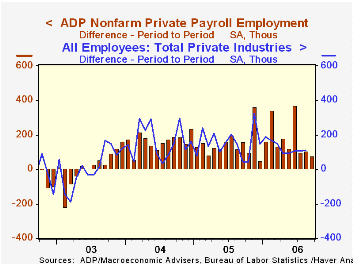
The Nat'l Employment Report, published by the payroll processor ADP, indicated that private nonfarm payrolls rose 78,000 last month. The September figure from BLS will be published this Friday.
During August, ADP's measure of private nonfarm payrolls rose 107,000 and that gain was accompanied by a 111,000 rise in private nonfarm payrolls, as published by the Bureau of Labor Statistics.
ADP compiled the estimate from its database of individual companies' payroll information. Macroeconomic Advisers, LLC, the St. Louis economic consulting firm, developed the methodology for transforming the raw data into an economic indicator.
According to ADP and Macro Advisers, the correlation between the monthly percentage change in the ADP estimate and that in the BLS data is 0.90.
The ADP National Employment Report data is maintained in Haver's USECON database; historical data go back to December 2000. The figures in this report cover only private sector jobs and exclude employment in the public sector, which grew an average of 11,333 per month over the last year.
The full ADP National Employment Report can be found here, and the ADP methodology is explained here.
The Coming Demographic Transition: Will We Treat Future Generations Fairly?, today's speech by Fed Chairman Bernanke is available here.
| LAXEPA@USECON | September | August | Y/Y | 2005 | 2004 | 2003 |
|---|---|---|---|---|---|---|
| Nonfarm Private Payroll Employment (Chg.) | 78,000 | 107,000 | 1.9% | 1.7% | 1.3% | -0.4% |
by Tom Moeller October 4, 2006

U.S. sales of light vehicles in September rose 3.5% to 16.63M units, according to the Autodata Corporation. The gain recovered a piece of the prior month's 6.5% decline and during the first nine months of 2006 vehicle sales averaged 16.63M, down 3.8% from the comparable period during.
A forty cent m/m decline in retail gasoline prices to an average $2.56 per gallon helped lift overall light truck sales 7.5% last month after a 6.6% decline during August. Nevertheless, higher gasoline prices versus last year have prompted an 8.3% decline in light truck sales year to date versus the first nine months of last year.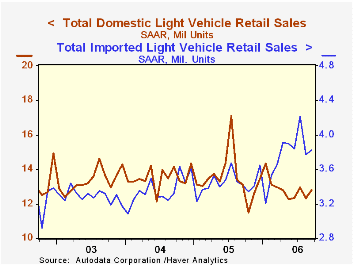
Sales of the relatively fuel efficient imported light trucks surged a strong 14.4% last month (29.8% y/y) and advanced 9.8% year to date. Domestic truck sales also rose 6.3% (1.0% y/y) during September, however, during the first nine months of this year domestic light truck sales fell 10.8% from the first nine months of 2005 to an average of 7.48M.
Auto sales slipped 0.8% last month after a 6.4% decline during August. Sales of imported autos fell 5.0% (+3.4% y/y) after a 10.1% August decline. Still, year to date sales of imported autos were up 9.2% versus 2005. Domestic car sales rose 1.2% (-6.6% y/y) after a 4.5% August decline. Year to date sales of domestic autos were down 1.2% versus last year.
Imports' share of the US light vehicle market fell m/m to 23.0% during September. Last year, imports' share of the U.S. vehicle market totaled 20.4%
Inflation Targets and Inflation Expectations: Some Evidence from the Recent Oil Shocks from the Federal Reserve Bank of San Francisco can be found here
| Light Vehicle Sales (SAAR, Mil. Units) | September | August | Y/Y | 2005 | 2004 | 2003 |
|---|---|---|---|---|---|---|
| Total | 16.63 | 16.06 | 0.7% | 16.96 | 16.87 | 16.63 |
| Autos | 7.63 | 7.69 | -3.6% | 7.65 | 7.49 | 7.62 |
| Trucks | 9.00 | 8.37 | 4.6% | 9.32 | 9.37 | 9.01 |
by Tom Moeller October 4, 2006
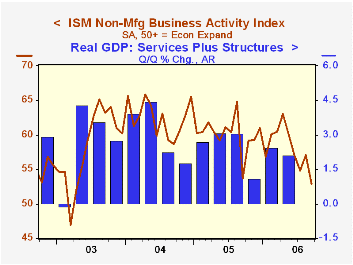
The September Business Activity Index for the non-manufacturing sector from the Institute for Supply Management (ISM) fell unexpectedly to its lowest level in over three years. The decline to 52.9 compared to Consensus expectations for a lesser drop to 56.0.
Since the series' inception in 1997 there has been a 50% correlation between the level of the Business Activity Index and the q/q change in real GDP for services plus construction.
The new orders sub-index rose to 57.2, recovering a sharp drop in August, and the employment index also recovered most of its August decline. Since the series' inception in 1997 there has been a 60% correlation between the level of the ISM non-manufacturing employment index and the m/m change in payroll employment in the service producing plus the construction industries.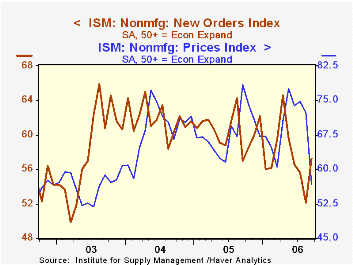
Pricing power dropped to its lowest level in three years. Since inception eight years ago, there has been a 70% correlation between the price index and the y/y change in the GDP services chain price index.
ISM surveys more than 370 purchasing managers in more than 62 industries including construction, law firms, hospitals, government and retailers. The non-manufacturing survey dates back to July 1997.Business Activity Index for the non-manufacturing sector reflects a question separate from the subgroups mentioned above. In contrast, the NAPM manufacturing sector composite index is a weighted average five components.
| ISM Nonmanufacturing Survey | September | August | Sept. '05 | 2005 | 2004 | 2003 |
|---|---|---|---|---|---|---|
| Business Activity Index | 52.9 | 57.0 | 53.7 | 60.1 | 62.5 | 58.3 |
| Prices Index | 56.7 | 72.4 | 78.4 | 67.9 | 68.8 | 56.6 |
by Tom Moeller October 4, 2006
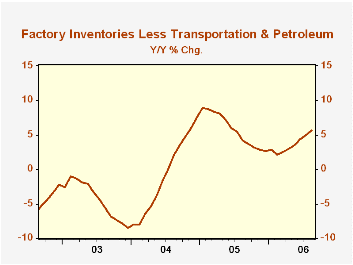
Factory inventories rose 0.4% last month, half the upwardly revised gain during July. Nevertheless, the y/y rate of accumulation was at its highest since early 2005.
Primary metals inventories again were firm and rose 1.4% (11.7% y/y) after an upwardly revised 2.1% increase during July. Growth in inventories of computers & electronic products slowed to 0.4% (8.5% y/y) from a 0.9% July gain but inventories of electrical equipment jumped another 1.5% (12.9% y/y). Machinery inventories rose 0.3% (4.5% y/y).
Total factory orders fell slightly after a deepened 1.0% July decline. Durable goods orders fell just slightly and that was a bit better than the 0.5% decline that was in the advance report of a 0.5% drop. Factory orders less transportation fell 0.7% (+5.5% y/y) after a 0.6% July gain.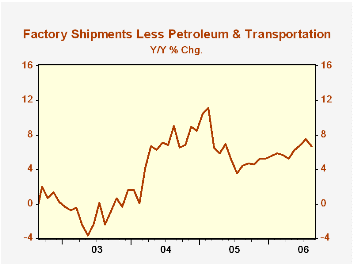
Factory shipments surged 1.1%on the strength of a 6.0% jump in transportation. Less transportation shipments rose 0.4% (6.9% y/y) despite lower petroleum shipments. Factory shipments less transportation & petroleum rose a strong 0.9% (6.7% y/y).
Unfilled orders rose 0.4% last month and less the transportation sector backlogs rose 0.3% (13.8% y/y).
| Factory Survey (NAICS) | August | July | Y/Y | 2005 | 2004 | 2003 |
|---|---|---|---|---|---|---|
| Inventories | 0.4% | 0.8% | 6.5% | 4.0% | 6.9% | -7.4% |
| New Orders | -0.0% | -1.0% | 4.6% | 8.5% | 7.5% | 0.9% |
| Shipments | 1.1% | -0.1% | 6.1% | 7.1% | 6.8% | 0.2% |
| Unfilled Orders | 0.4% | 1.2% | 18.5% | 16.3% | 4.5% | -1.0% |
by Tom Moeller October 4, 2006

According to the Mortgage Bankers Association. the total number of mortgage applications surged 11.9% last week. It was the strongest w/w increase since June 2005. The gain lifted applications for the month 5.6% above the August average.
Applications to refinance surged 17.5% after the prior week's 4.1% decline. The average level of refis in September rose 8.7% from August which surged 13.3% m/m from July.
Purchase applications recovered 7.6% after the prior week's 5.5% decline. The increase raised the month's average 3.2% from August, only the first rise in the last five months. The latest level was 23.1% below the peak during May of 2005.
During the last ten years there has been a 58% correlation between the y/y change in purchase applications and the change in new plus existing single family home sales.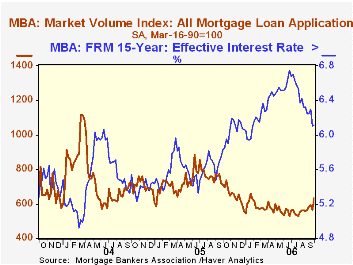
The effective interest rate on a conventional 30-year mortgage rose six basis points to 6.39% to 6.45% and averaged 6.50% last month versus 6.64% in August. The peak for 30 year financing was 7.08% late in June. The rate on 15-year financing ticked just slightly w/w to 6.11% and averaged 6.20% last month. The peak rate was 6.75%. Interest rates on 15 and 30 year mortgages are closely correlated (>90%) with the rate on 10 year Treasury securities.
During the last ten years there has been a (negative) 79% correlation between the level of applications for purchase and the effective interest rate on a 30-year mortgage.
The Mortgage Bankers Association surveys between 20 to 35 of the top lenders in the U.S. housing industry to derive its refinance, purchase and market indexes. The weekly survey accounts for more than 40% of all applications processed each week by mortgage lenders. Visit the Mortgage Bankers Association site here.
| MBA Mortgage Applications (3/16/90=100) | 09/29/06 | 09/22/06 | Y/Y | 2005 | 2004 | 2003 |
|---|---|---|---|---|---|---|
| Total Market Index | 633.9 | 566.5 | -11.2% | 708.6 | 735.1 | 1,067.9 |
| Purchase | 404.6 | 375.9 | -14.6% | 470.9 | 454.5 | 395.1 |
| Refinancing | 1,970.8 | 1,677.5 | -6.5% | 2,092.3 | 2,366.8 | 4,981.8 |
by Carol Stone October 4, 2006
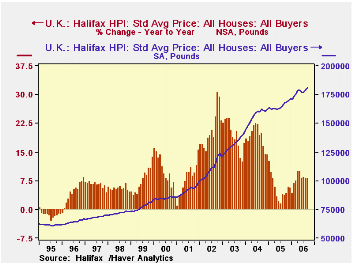
Unlike in the US, the property market in the UK is still strong. Home prices published today by the Halifax Royal Bank of Scotland (HBOS) showed a 1.0% monthly increase in September, seasonally adjusted. August was revised upward to 1.3% from 1.0% reported initially. September's price stood 8.2% above a year ago; the growth rate in the three-month moving average most frequently cited by the bank was 8.0%. This is less than in the prior four months, but firmer than what prevailed across 2005.
For comparison, we can look at the price in US dollars; it was $342,000. A slight firming in the dollar diminished September's sterling price gain in to 0.4% in the US currency, but that followed a 4.0% surge in August when the dollar had fallen 2.6% again the pound.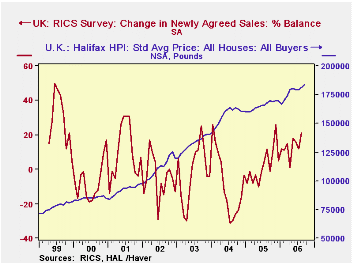
The firmness in UK house prices is presently accompanying firm demand for houses in the UK, suggested by the positive readings in the RICS housing market survey. Data on actual counts of home sales transactions lag a couple of months. But this survey by Chartered Surveyors gives the balance of respondents showing more "newly agreed sales" over fewer sales at +21% in August, the second highest since early 2004.
Analysts were impressed with the strength in home prices, even as interest rates are also moving up. In early August, the Bank of England raised its base rate 25 basis points to 4.75%. This appears not yet fully reflected in available data on mortgage rates, which show the "standard variable rate" inching up just 2 basis points in August to 6.50% from 6.48% in July. The "base-rate tracker" mortgage rate rose in August to 5.30% from 5.16% in July. The higher house prices suggest that rising mortgage rates didn't discourage buyers in September -- or perhaps they stimulated buyers in the reverse way: "let's get our house and our mortgage now before rates go up more", they may have thought, which circumstance would point to a slowdown in coming months.
| UK House Prices | Sept 2006 | Aug 2006 | July 2006 | Year Ago | 2005 | 2004 | 2003 |
|---|---|---|---|---|---|---|---|
| Average House Price (SA*, £000) | 181.2 | 179.5 | 177.2 | 167.5 | 165.3 | 157.0 | 132.2 |
| % Chg | 1.0 | 1.3 | 0.3 | 8.2 | 5.3 | 18.8 | 19.0 |
| US $ (000) | 341.5 | 340.0 | 326.9 | 302.9 | 300.7 | 287.6 | 216.4 |
| % Chg | 0.4 | 4.0 | 0.4 | 12.8 | 4.6 | 32.9 | 29.2 |
| RICS Newly Agreed Sales** | -- | +21% | +12% | +12% | +2% | -9% | -2% |
| Mortgage Rate*** | -- | 6.50% | 6.48% | 6.71% | 6.63% | 6.25% | 5.61% |
Tom Moeller
AuthorMore in Author Profile »Prior to joining Haver Analytics in 2000, Mr. Moeller worked as the Economist at Chancellor Capital Management from 1985 to 1999. There, he developed comprehensive economic forecasts and interpreted economic data for equity and fixed income portfolio managers. Also at Chancellor, Mr. Moeller worked as an equity analyst and was responsible for researching and rating companies in the economically sensitive automobile and housing industries for investment in Chancellor’s equity portfolio. Prior to joining Chancellor, Mr. Moeller was an Economist at Citibank from 1979 to 1984. He also analyzed pricing behavior in the metals industry for the Council on Wage and Price Stability in Washington, D.C. In 1999, Mr. Moeller received the award for most accurate forecast from the Forecasters' Club of New York. From 1990 to 1992 he was President of the New York Association for Business Economists. Mr. Moeller earned an M.B.A. in Finance from Fordham University, where he graduated in 1987. He holds a Bachelor of Arts in Economics from George Washington University.






